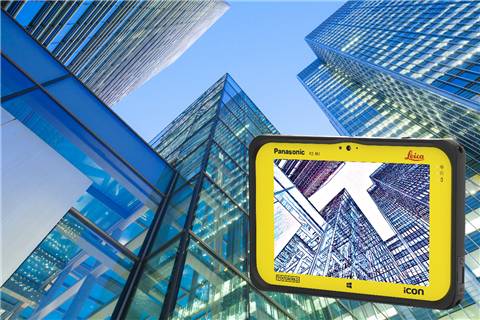Digital twins: What are they and what do they do?
02 February 2022
Until recently, the concept of the ‘Digital Twin‘, where digitised versions of physical assets are updated in real-time with real world sensors, was thought of as science fiction.
Today, we are starting to see the concept being adopted in successful building-wide installations across the globe.
In this article, Leica Geosystems’ content marketing executive, Simon Hall, examines the role digital twins play in construction.
 Photo: Leica Geosystems
Photo: Leica Geosystems
Historically, the construction industry has relied on 2D datasets to create the designs and plans that are used during construction.
2D datasets alone, particularly those that are not up-to-date, provide a huge risk to companies, meaning critical decisions are based on inaccurate information.
Even during construction, capturing real-world information regularly can help avoid those costly mistakes that occur.
Over the last decade, the construction industry has begun to embrace new techniques and technology that help provide rapid, real-world data capture. Laser scanning and the recent growth in popularity of UAVs, and the imagery information they provide, are two examples.
The biggest barrier for people is handling this large stream of data and integrating the data into their existing workflows.
Investment in a comprehensive digital twin technologies can help construction companies to optimize the design, engineering, construction, operation and maintenance of industrial assets.
What is a digital twin?
A digital twin is a digital version or representation of a physical asset in the real world. Although, this is a very simplistic defintion for something that is actually so much more than that.
Updated in real-time with real world sensors, a digital twin is essentially the glue that connects the information and processes used across the whole asset lifecycle on one platform, enabling the single version of the truth concept.
How is a digital twin set up?
Stage 1 - A digital twin starts with a basic set of structured data and documents defining the facility configuration, designed by engineering teams in the Project Twin.
For companies near the beginning of their digital transformation roadmap, this is an excellent start, empowering better decision making from more intelligent data and improving engineering-to-operations handover processes.
Stage 2 - The second stage of connecting this intelligent data to 2D schematics, 3D models or laser scans allows for more intuitive viewing and navigation and begins to unlock the benefits of weaving engineering, operations and maintenance information in an Operational Twin.
Stage 3 - This involves further enhancing the Operational Twin with increased interoperability by exchanging information and providing links to other information sources in the operations landscape, such as asset performance, data historian, maintenance management and real-time data solutions.
Stage 4 - This is where the major digital transformation business benefits will be realized, as the asset owners and operators can leverage a digital twin to manage value added work processes, such as human procedures, inspections, integrated safe systems of work and management of change.
This ongoing stage of value addition can also include advanced analytics, artificial intelligence, machine learning and predictive and prescriptive analytics to reduce downtime.
Deployment of a digital twin
When a comprehensive digital twin is deployed, the associated data needs to be efficiently dissected to understand it and to also transform this into actionable information.
To help achieve this, Leica’s Hexagon Situational Awareness product allows personnel to clearly see what’s happened, what’s happening, what could happen, what should happen and what’s scheduled to happen in a high-level operational dashboard that includes all the visual elements of a digital twin.
Stuart Smith of Knights Construction - a UK company that provides construction and design & duild services, said, “When you talk about productivity and efficiency, there are savings to be had using the Leica system.
“For us in our game, specialising in agricultural buildings, we can offer the savings up to our clients, but you’ve also got the environmental savings as well.”
Smith added, “With these systems, we have completed earthworks projects that normally take a month in just two weeks, it’s a massive saving.”
Why use a digital twin?
Overall, the goal of any digital twin is to increase asset efficiency and offer a digital representation of current and historic plant configurations, along with related performance information.
Enlightened, data-driven decision making becomes the norm, and the easy sharing of digital twin data with multiple departments increases collaboration and reduces operational risk.
Hexagon solutions help people design, engineer, construct, operate and maintain industrial assets, and the Project Twin, Operational Twin and Situational Awareness solutions allow asset owners and operators to build and maintain a Digital Twin ecosystem throughout the asset lifecycle, allowing for a continuous journey of operational excellence.
Matt Thompson, Virtual Manufacturing Engineering Manager at Jaguar Land Rover in the UK, said, “With Leica solutions, we can quickly scan spaces in-house, create CAD models within a few hours and provide stakeholders the required deliverable to design, modify and install equipment in our facility.
“Instead of relying on external providers, we can identify the need and activate a team to provide the survey data within a day.”
STAY CONNECTED



Receive the information you need when you need it through our world-leading magazines, newsletters and daily briefings.
CONNECT WITH THE TEAM







